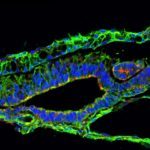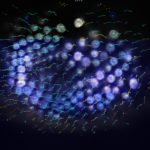Link to Pubmed [PMID] – 35413235
Link to DOI – 10.1016/j.devcel.2022.03.004
Dev Cell 2022 Apr; 57(7): 854-866.e6
During embryonic development, digits gradually emerge in a periodic pattern. Although genetic evidence indicates that digit formation results from a self-organizing process, the underlying mechanisms are still unclear. Here, we find that convergent-extension tissue flows driven by active stresses underlie digit formation. These active stresses simultaneously shape cartilage condensations and lead to the emergence of a compressive stress region that promotes high activin/p-SMAD/SOX9 expression, thereby defining digit-organizing centers via a mechanical feedback. In Wnt5a mutants, such mechanical feedback is disrupted due to the loss of active stresses, organizing centers do not emerge, and digit formation is precluded. Thus, digit emergence does not result solely from molecular interactions, as was previously thought, but requires a mechanical feedback that ensures continuous coupling between phalanx specification and elongation. Our work, which links mechanical and molecular signals, provides a mechanistic context for the emergence of organizing centers that may underlie various developmental processes.






